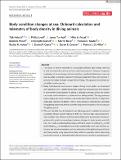Files in this item
Body condition changes at sea : onboard calculation and telemetry of body density in diving animals
Item metadata
| dc.contributor.author | Adachi, Taiki | |
| dc.contributor.author | Lovell, Philip | |
| dc.contributor.author | Turnbull, James | |
| dc.contributor.author | Fedak, Mike | |
| dc.contributor.author | Picard, Baptiste | |
| dc.contributor.author | Guinet, Christophe | |
| dc.contributor.author | Biuw, Martin | |
| dc.contributor.author | Keates, Theresa R. | |
| dc.contributor.author | Holser, Rachel R. | |
| dc.contributor.author | Costa, Daniel P. | |
| dc.contributor.author | Crocker, Daniel E. | |
| dc.contributor.author | Miller, Patrick James | |
| dc.date.accessioned | 2023-04-05T09:30:12Z | |
| dc.date.available | 2023-04-05T09:30:12Z | |
| dc.date.issued | 2023-06-07 | |
| dc.identifier | 283576415 | |
| dc.identifier | b160d98a-b4a5-4ed2-83a8-b77648d6af02 | |
| dc.identifier | 85151759891 | |
| dc.identifier.citation | Adachi , T , Lovell , P , Turnbull , J , Fedak , M , Picard , B , Guinet , C , Biuw , M , Keates , T R , Holser , R R , Costa , D P , Crocker , D E & Miller , P J 2023 , ' Body condition changes at sea : onboard calculation and telemetry of body density in diving animals ' , Methods in Ecology and Evolution , vol. 14 , no. 6 , pp. 1457-1474 . https://doi.org/10.1111/2041-210x.14089 | en |
| dc.identifier.issn | 2041-210X | |
| dc.identifier.other | ORCID: /0000-0002-9569-1128/work/132764133 | |
| dc.identifier.uri | https://hdl.handle.net/10023/27333 | |
| dc.description | Funding: This study was supported by grants from the Office of Naval Research N00014-18-1-2822, DoD SERDP contract W912HQ20C0056, IPEV (Institut Paul Emile Victor) under the Antarctic research program 109 (C. Barbraud) and 1201 (C. Gilbert & C. Guinet), and CNES-TOSCA as part of the SNO-MEMO. | en |
| dc.description.abstract | The ability of marine mammals to accumulate sufficient lipid energy reserves is vital for mammals' survival and successful reproduction. However, long-term monitoring of at-sea changes in body condition, specifically lipid stores, has only been possible in elephant seals performing prolonged drift dives (low-density lipids alter the rates of depth change while drifting). This approach has limited applicability to other species. Using hydrodynamic performance analysis during transit glides, we developed and validated a novel satellite-linked data logger that calculates real-time changes in body density (∝lipid stores). As gliding is ubiquitous amongst divers, the system can assess body condition in a broad array of diving animals. The tag processes high sampling rate depth and three-axis acceleration data to identify 5 s high pitch angle glide segments at depths >100 m. Body density is estimated for each glide using gliding speed and pitch to quantify drag versus buoyancy forces acting on the gliding animal. We used tag data from 24 elephant seals (Mirounga spp.) to validate the onboard calculation of body density relative to drift rate. The new tags relayed body density estimates over 200 days and documented lipid store accumulation during migration with good correspondence between changes in body density and drift rate. Our study provided updated drag coefficient values for gliding (Cd,f = 0.03) and drifting (Cd,s = 0.12) elephant seals, both substantially lower than previous estimates. We also demonstrated post-hoc estimation of the gliding drag coefficient and body density using transmitted data, which is especially useful when drag parameters cannot be estimated with sufficient accuracy before tag deployment. Our method has the potential to advance the field of marine biology by switching the research paradigm from indirectly inferring animal body condition from foraging effort to directly measuring changes in body condition relative to foraging effort, habitat, ecological factors and anthropogenic stressors in the changing oceans. Expanding the method to account for diving air volumes will expand the system's applicability to shallower-diving (<100 m) species, facilitating real-time monitoring of body condition in a broad range of breath-hold divers. | |
| dc.format.extent | 18 | |
| dc.format.extent | 4324653 | |
| dc.language.iso | eng | |
| dc.relation.ispartof | Methods in Ecology and Evolution | en |
| dc.subject | Animal health | en |
| dc.subject | Bio-logging | en |
| dc.subject | Body density | en |
| dc.subject | Buoyancy | en |
| dc.subject | Marine mammal | en |
| dc.subject | Real-time monitoring | en |
| dc.subject | Satellite transmission | en |
| dc.subject | QL Zoology | en |
| dc.subject | GC Oceanography | en |
| dc.subject | DAS | en |
| dc.subject | SDG 14 - Life Below Water | en |
| dc.subject | MCC | en |
| dc.subject.lcc | QL | en |
| dc.subject.lcc | GC | en |
| dc.title | Body condition changes at sea : onboard calculation and telemetry of body density in diving animals | en |
| dc.type | Journal article | en |
| dc.contributor.institution | University of St Andrews. Marine Alliance for Science & Technology Scotland | en |
| dc.contributor.institution | University of St Andrews. Scottish Oceans Institute | en |
| dc.contributor.institution | University of St Andrews. Sea Mammal Research Unit | en |
| dc.contributor.institution | University of St Andrews. School of Biology | en |
| dc.contributor.institution | University of St Andrews. Institute of Behavioural and Neural Sciences | en |
| dc.contributor.institution | University of St Andrews. Centre for Social Learning & Cognitive Evolution | en |
| dc.contributor.institution | University of St Andrews. Bioacoustics group | en |
| dc.identifier.doi | 10.1111/2041-210x.14089 | |
| dc.description.status | Peer reviewed | en |
This item appears in the following Collection(s)
Items in the St Andrews Research Repository are protected by copyright, with all rights reserved, unless otherwise indicated.

